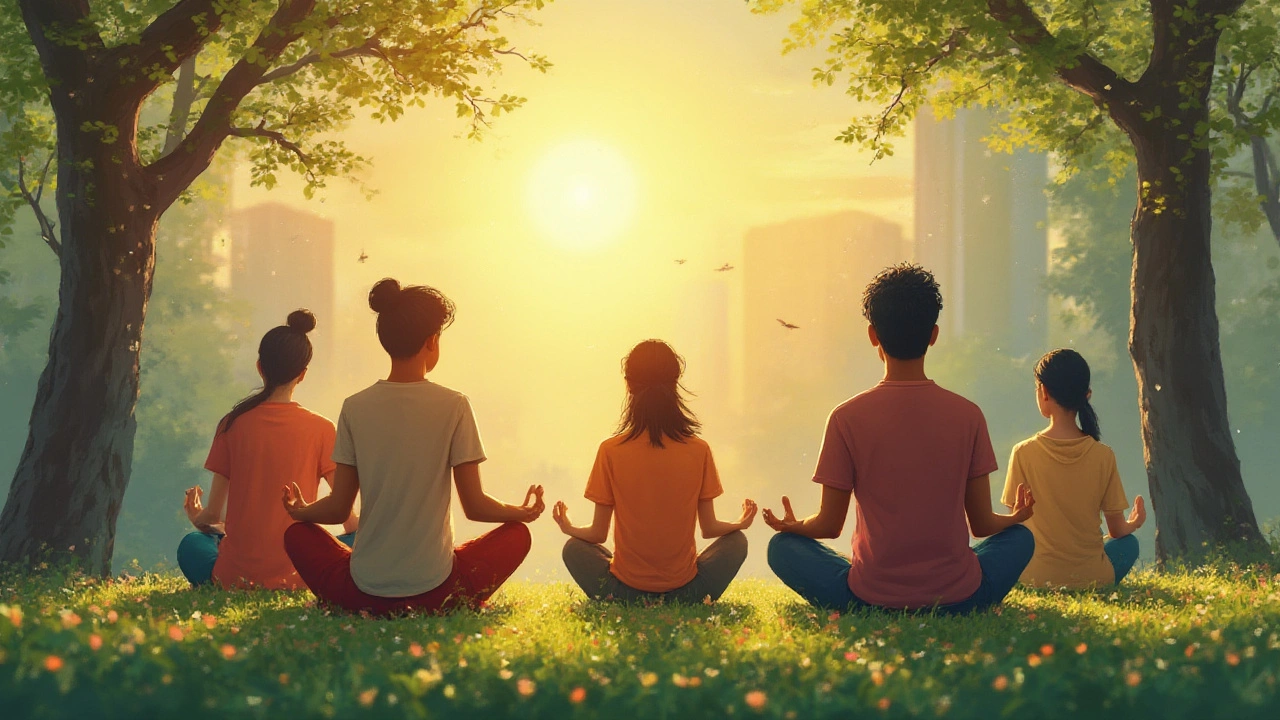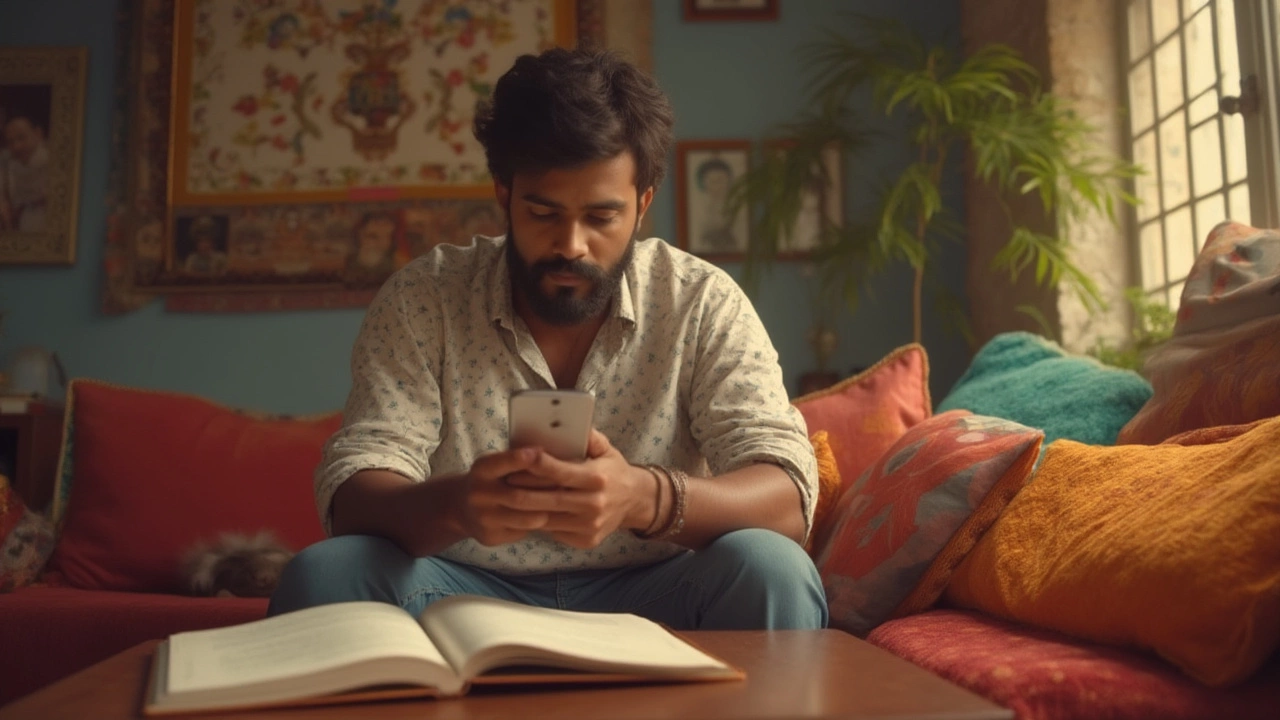
- Jul, 14 2025
- 0
Ever wondered if you really need a therapist to heal? Today, more people than ever are skipping the couch and exploring their own path to mental wellness. Sure, therapy works. But it’s not the only road leading to healing. There’s a world of evidence-backed self-help options and ancient wisdom that suggest people are more resilient and creative than they sometimes give themselves credit for. Take a look at those quiet afternoons when you walk alone and start feeling lighter—or the sense of peace washing over you after putting your thoughts on paper. Science proves our brains love small changes, and more folks are waking up to healing without professional help.
In 2023, the World Health Organization reported that over a billion people experience mental health challenges, but less than half ever see a therapist. That gap isn’t just about access. It’s about belief—trusting you can find relief and maybe even thrive outside the formal therapy room. Why is that? Is it about cost, stigma, or something deeper? Let’s get curious about the real reasons people look outside therapy, and what can actually work if you decide to heal on your own.
Why People Turn to Self-Healing: The Real Motivators
There’s no denying therapy is proven to help with everything from anxiety to relationship troubles. But life isn’t always set up to give us perfect timing or resources. Many who skip therapy point to costs: sessions can run between INR 500 to over INR 5000 per hour in cities across India—and insurance rarely covers it. And then there’s the wait. In busy cities, new patients sometimes have to wait weeks or months to get a slot.
But money and availability aren’t the whole story. In some homes and cultures, talking about personal struggles can feel awkward or shameful. People might not want their family—or even their friends—to know they’re struggling. Privacy matters. And sometimes the simple act of asking for help feels heavier than the problem itself. This is especially true for men: a 2023 survey found that 61% of Indian men say they’d rather "deal with it alone" than share openly in therapy.
The good news? Motivation to heal often turns people into their own best resource. Experts from Harvard Medical School note, “Most people have the capacity to be active agents in their own recovery.” Our brains are actually wired for self-repair. Neuroplasticity, that clever feature where your mind rewires itself, doesn’t stop at any age, even when tackling depression, trauma, or stress. Sometimes, what we need most is the permission to start and some workable tools.
There’s a myth that therapy is the "only way" to heal mentally. In reality, research shows that self-guided recovery methods—journaling, building routines, connecting with close friends—are effective, especially for mild to moderate mental health issues. For severe challenges, like suicidal thinking or psychosis, therapy remains essential. But for more common struggles? Healing without therapy isn’t just possible; it’s happening every day.

DIY Healing: What Actually Works When You Skip Therapy
No magic pill here, but a bunch of well-studied practices make self-healing more than possible. Mindfulness and meditation top the list. The Indian Journal of Psychiatry published a study in March 2024 where daily mindfulness for eight weeks reduced anxiety and depression scores by 30% for participants—no therapist needed. You can start with simple five-minute guided meditations or even focused breathing exercises. Don’t be afraid to experiment with apps; Headspace and Calm, for example, both have India-specific content now.
Writing can work like free therapy. Whether you keep a gratitude journal, write angry letters you never send, or scribble feelings on a napkin, the act of putting words down changes how the brain processes stress. In fact, a 2022 study in Mumbai found university students who wrote about difficult emotions for 20 minutes daily had “markedly lower” stress hormone levels than those who didn’t. If you can’t find the exact words, drawing or making music works just as well.
Movement matters too, a lot more than most people think. Physical activity triggers the release of endorphins, which act like natural antidepressants. You don’t have to become a gym rat. Walking, dancing in your room, or stretching out on the floor with YouTube yoga videos does the trick. One 2023 survey in Delhi saw office workers reporting 40% better moods when they walked during their lunch breaks for two weeks versus those who just scrolled on their phones.
Routine is another unsung hero. Building even a loosely structured daily rhythm—wake, eat, sleep, and a little play at the same time each day—helps the mind feel safe and grounded. People with consistent routines bounce back faster from stressful life changes and report fewer symptoms of depression. Start with one thing—a bedtime, a morning walk, an evening phone-off hour—and stack from there.
Connection, though, stays at the core. Even introverts benefit from having one or two trusted people to check in with—no therapist title required. Setting up a weekly "mental health check-in" with a friend or sibling can bring relief and accountability. Want evidence? In Bengaluru, a grassroots peer-support group called MINDLINK showed that participants sharing their struggles in small groups reported 50% less loneliness after just a month.
Mood trackers and self-assessment tools can also offer insight. Try apps like Moodpath, or simple pen-and-paper charts. You’ll start to see what triggers good or bad days, helping you plan ahead. Smart self-care isn’t about luxury; it’s as basic as eating decent food, sleeping enough, and stepping outside to soak up twenty minutes of sunlight.
Learning helps too. There are countless books and podcasts on mental health. Dr. Bessel van der Kolk’s "The Body Keeps the Score" remains a global favorite on trauma and healing. Or, for free advice backed by science, look up “The Happiness Lab” podcast. Knowledge builds confidence, which is a strong antidote to feeling helpless.
Of course, self-healing is easier for some than others, and it’s not about doing it all perfectly. It’s about having options, testing what eases your mind, and trusting that small changes can add up. If things worsen or nothing seems to help, reaching out for therapy or crisis support is never the wrong move.
| Self-Healing Method | Effectiveness (as per studies) | Easy to Start? |
|---|---|---|
| Mindfulness Meditation | Reduces anxiety by 30% | Yes |
| Journaling | Lowers stress hormones significantly | Yes |
| Physical Activity | Improves mood by up to 40% | Yes |
| Routine Building | Reduces depressive symptoms | Yes |
| Peer Connection | Cuts loneliness in half | Yes |

Danger Zones and Knowing When You Need More Than DIY
Healing on your own is empowering, but there are cracks you shouldn’t ignore. Sometimes, problems feel too heavy to carry silently. Watch out for "red flag" signs that self-healing just isn’t enough. If you’re thinking about harm, feeling detached from reality, binge drinking or using drugs to numb the pain, or completely withdrawing from life, waiting it out alone can make things worse. Suicide rates in India went up 7% in 2022, according to the National Crime Records Bureau, with a worrying number never asking for help.
The mind can trick us into thinking we should "try harder" when what we really need is professional intervention. Chronic sleep issues, panic attacks, terrifying nightmares, or persistent feelings of worthlessness don’t usually resolve with home remedies. Facing trauma from abuse or loss often calls for skilled guidance; there’s no shame in bringing in the experts. Psychiatrist Dr. Shekhar Saxena once said,
“We must move away from the idea that seeking help is a sign of weakness. For many, it is the first step to real healing.”
Cultural pressure and social media also play sneaky roles. Scrolling through perfect lives can deepen sadness and shame, even when you’re doing all the "right" self-care things. Here’s a tip: unfollow accounts that make you feel small or not enough, and follow creators who talk honestly about struggles.
Insurance options are opening up, but finding affordable therapy is still tough. Some organizations, like YourDOST in India, offer sliding scale rates or free sessions. If things feel tough and you’re not sure where to start, these can be easier doors to open than traditional clinics. And don’t discount talking to a family doctor, who can sometimes connect you with therapists or support groups for little or no cost.
There’s a middle ground too—consider "guided self-help," where digital apps, online workshops, or mental health coaches offer direction. This format saw a surge in the pandemic era, and studies from 2022 in Tamil Nadu found it improved depression recovery nearly as well as classical therapy for many people. It’s about support, not isolation.
Trust yourself to recognize when you hit a wall. Google Mental Health Helpline India if ever in danger, and know that asking for help can coexist with all your independent healing. Nobody has to pick just one path.
Healing without therapy is absolutely possible, especially with mild to moderate issues, and often gives you a sense of control that’s priceless. The big secret? Try things, adjust as you go, and remember: it’s your journey. Trained help is always there if you need it. For most people, real growth comes from a mix of self-led and supported steps. Ready to give self-healing a shot? Start now—the smallest action might be the biggest thing you do for yourself.
Nikhil Verma
I'm a dedicated physician with a passion for exploring the intricacies of medicine, focusing on the unique healthcare challenges in India. I spend much of my spare time writing articles aimed at improving public understanding of health issues. Balancing my clinical practice and writing allows me to reach a wider audience, sharing insights and fostering a deeper appreciation for medical advancements. I derive immense satisfaction from both treating patients and engaging with readers through my writing.